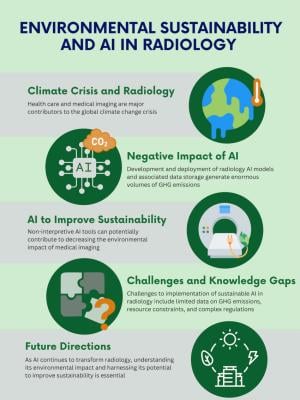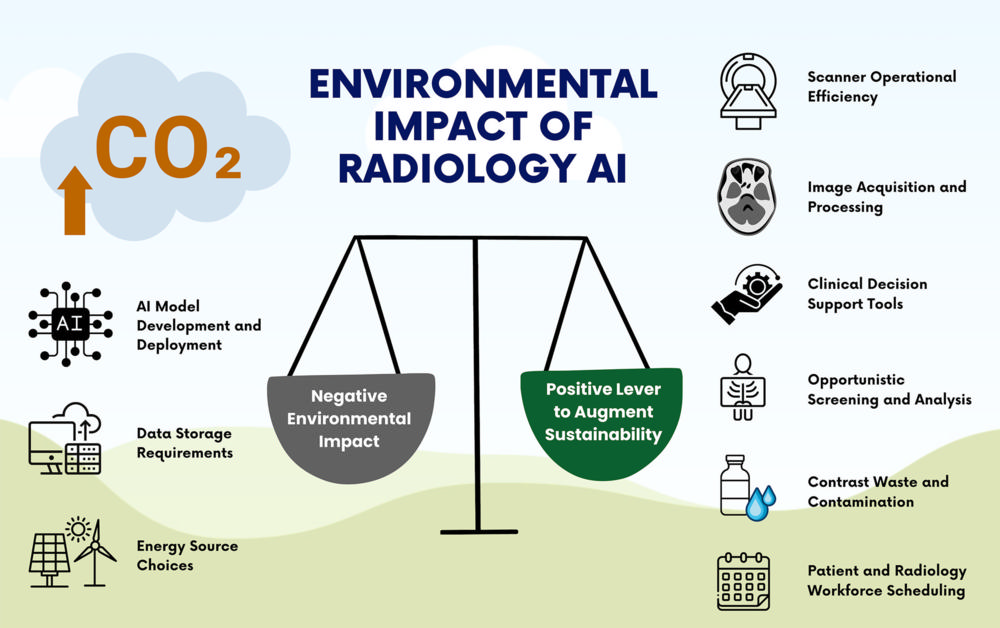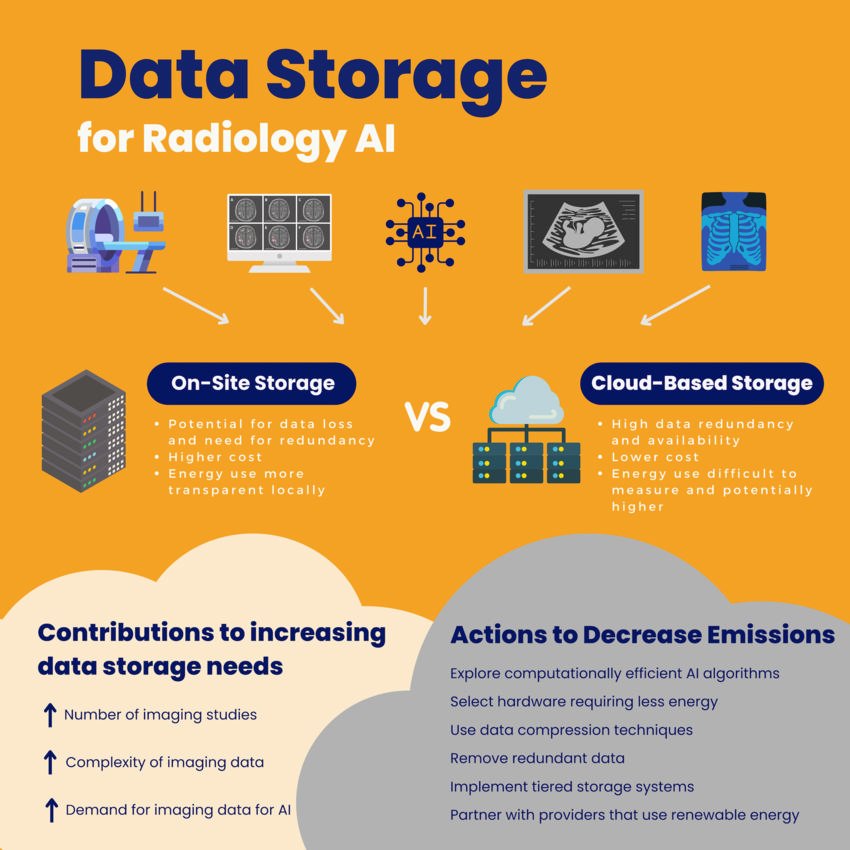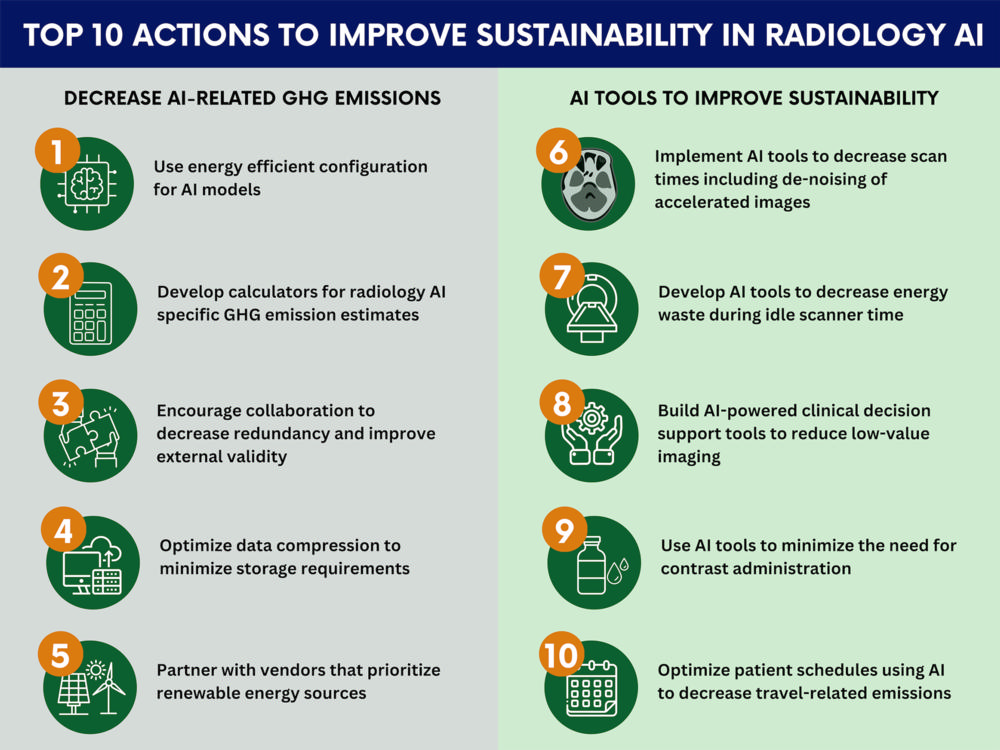
A new report, “Environmental Sustainability and AI in Radiology: A Double-Edged Sword,” published in the RSNA journal, Radiology, is shedding light on the environmental impact of associated data storage and artificial intelligence (AI) tools. According to co-author, Kate Hanneman, MD, MPH, vice chair of research and associate professor at the University of Toronto and deputy lead of sustainability at the Joint Department of Medical Imaging, Toronto General Hospital, “We need to do a balancing act, bridging to the positive effects while minimizing the negative impacts.”
Figure 1. Summary of the intersection of environmental sustainability and artificial intelligence (AI) in radiology. GHG = greenhouse gas. Images courtesy: RSNA
February 27, 2024 — As artificial intelligence (AI) is increasingly used in radiology, researchers caution that it’s essential to consider the environmental impact of AI tools, according to a focus article published today in Radiology, a journal of the Radiological Society of North America (RSNA).
Healthcare and medical imaging significantly contribute to the greenhouse gas (GHG) emissions fueling global climate change, according to the report, “Environmental Sustainability and AI in Radiology: A Double-Edged Sword." It further reported that AI tools can improve both the practice of and sustainability in radiology through optimized imaging protocols resulting in shorter scan times, improved scheduling efficiency to reduce patient travel, and the integration of decision-support tools to reduce low-value imaging. But there is a downside to AI utilization.
“Medical imaging generates a lot of greenhouse gas emissions, but we often don’t think about the environmental impact of associated data storage and AI tools,” said Kate Hanneman, M.D., M.P.H., vice chair of research and associate professor at the University of Toronto and deputy lead of sustainability at the Joint Department of Medical Imaging, Toronto General Hospital. She added, “The development and deployment of AI models consume large amounts of energy, and the data storage needs in medical imaging and AI are growing exponentially.”

Kate Hanneman, M.D., M.P.H.
Dr. Hanneman and a team of researchers looked at the benefits and downsides of incorporating AI tools into radiology. In addition to Hanneman, authors included: Florence X. Doo, MD, PhD, University of Maryland; Jan Vosshenrich, MD, University Hospital, Basel; Tessa S. Cook, MD, Penn Medicine; Linda Moy, MD, NYU School of Medicine, editor of the journal Radiology; Eduardo P.R.P. Almeida, MD; Sean A. Woolen, MD, University of California, San Francisco; Judy Wawira Gichoya, MD, MS, Emory University; and Tobias Heye, MD. The team found that AI offers the potential to improve workflows, accelerate image acquisition, reduce costs and improve the patient experience. However, the energy required to develop AI tools and store the associated data significantly contributes to GHG.
“We need to do a balancing act, bridging to the positive effects while minimizing the negative impacts,” Dr. Hanneman said. “Improving patient outcomes is our ultimate goal, but we want to do that while using less energy and generating less waste.”
Developing AI models requires large amounts of training data that health care institutions must store along with the billions of medical images generated annually. Many health systems use cloud storage, meaning the data is stored off-site and accessed electronically when needed.
“Even though we call it cloud storage, data are physically housed in centers that typically require large amounts of energy to power and cool,” Dr. Hanneman said. “Recent estimates suggest that the total global GHG emissions from all data centers is greater than the airline industry, which is absolutely staggering.”

Figure 2. Summary of how artificial intelligence (AI) in radiology has a negative impact on the environment, with key opportunities and actions to improve sustainability using AI in radiology.
The location of a data center has a massive impact on its sustainability, especially if it’s in a cooler climate or in an area where renewable energy sources are available.
To minimize the overall environmental impact of data storage, the researchers recommended sharing resources and, where possible, collaborating with other providers and partners to distribute the expended energy more broadly.

Figure 3. Summary of on-site and cloud-based data storage options for artificial intelligence (AI) in radiology, why data storage needs are increasing, and recommended actions to decrease the resulting greenhouse gas emissions.
To decrease GHG emissions from data storage and the AI model development process, the researchers also offered other suggestions. These included exploring computationally efficient AI algorithms, selecting hardware that requires less energy, using data compression techniques, removing redundant data, implementing tiered storage systems and partnering with providers that use renewable energy.
“Departments that manage their cloud storage can take immediate action by choosing a sustainable partner,” she said.
Dr. Hanneman said although challenges and knowledge gaps remain, including limited data on radiology specific GHG emissions, resource constraints and complex regulations, she hopes sustainability will become a quality metric in the decision-making process around AI and radiology.
“Environmental costs should be considered along with financial costs in health care and medical imaging,” she said. “I believe AI can help us improve sustainability if we apply the tools judiciously. We just need to be mindful and aware of its energy usage and GHG emissions.”
For more information: www.rsna.org

Figure 4. Summary of on-site and cloud-based data storage options for artificial intelligence (AI) in radiology, why data storage needs are increasing, and recommended actions to decrease the resulting greenhouse gas emissions.


 January 06, 2026
January 06, 2026 









